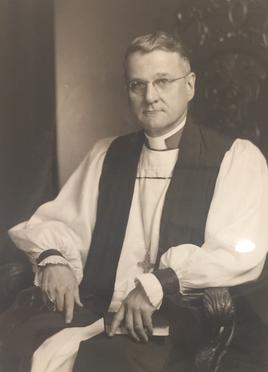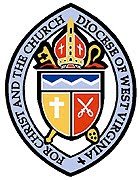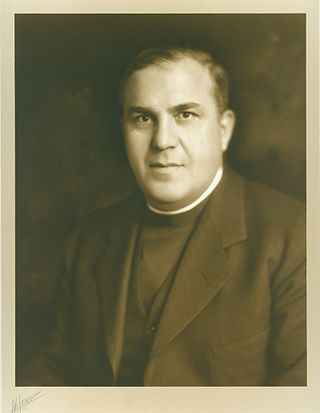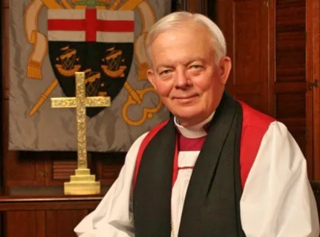
Frank Tracy Griswold III was an American clergyman who served as the 25th Presiding Bishop of the Episcopal Church.

The Anglican Province of America (APA) is a Continuing Anglican church in the United States. The church was founded by former members of the Episcopal Church in the United States.

The Episcopal Diocese of Maryland forms part of Province 3 of the Episcopal Church in the United States of America. Having been divided twice, it no longer includes all of Maryland and now consists of the central, northern, and western Maryland counties of Allegany, Anne Arundel, Baltimore, Calvert, Carroll, Frederick, Garrett, Harford, Howard, and Washington, as well as the independent city of Baltimore.

The Episcopal Diocese of Pittsburgh is a diocese in the Episcopal Church in the United States of America. Geographically, it encompasses 11 counties in Western Pennsylvania. It was formed in 1865 by dividing the Episcopal Diocese of Pennsylvania. The diocesan cathedral is Trinity Cathedral in downtown Pittsburgh. The Rt. Rev. Ketlen A. Solak was consecrated and seated as its current bishop in autumn 2021.

The Episcopal Diocese of North Carolina is a diocese of the Episcopal Church within Province IV that encompasses central North Carolina. Founded in 1817, the modern boundaries of the diocese roughly correspond to the portion of North Carolina between I-77 in the west and I-95 in the east, including the most populous area of the state. Raleigh, Charlotte, Winston-Salem, Greensboro, and Durham are the largest cities in the diocese. The diocese originally covered the entirety of the state, until the Diocese of East Carolina which stretches to the Atlantic was formed in 1883, and the Diocese of Western North Carolina which lies to the west extending into the Appalachian Mountains was formed in 1922.

Michael Bruce Curry is an American bishop who is the 27th and current Presiding Bishop and primate of the Episcopal Church. Elected in 2015, he is the first African American elected to the role, having previously served as Bishop of North Carolina from 2000 to 2015. His tenure as Presiding Bishop will end in October 2024 and he will be succeeded by Sean Rowe.

Harry Lee Doll, was bishop of the Episcopal diocese of Maryland during the turmoil concerning civil rights for minorities and women in the 1960s.

The Episcopal Diocese of West Virginia is a diocese of the Episcopal Church in the United States of America (TEC). It encompasses all 55 counties of West Virginia. The diocese has 66 congregations, including 38 parishes, 26 missions, and 2 other churches. The diocese is headquartered in Charleston and led by The Rt. Rev. Matthew Davis Cowden who was consecrated as bishop coadjutor in March, 2022 and became bishop diocesan in October, 2022.
Alden Moinet Hathaway is an American Episcopal and Anglican bishop. He served as the sixth bishop of the Episcopal Diocese of Pittsburgh, from 1983 to 1997. His time in office emphasized the role of his diocese as one of the most theologically conservative of the Episcopal Church. He has been a retired bishop of the Anglican Church in North America since 2017.

Karl Morgan Block was the fourth bishop of the Episcopal Diocese of California.

Peter James Lee was an American bishop of the Episcopal Church.
William Theodotus Capers was bishop of the Diocese of West Texas in the Episcopal Church in the United States from 1916 until his death.
Goodrich Robert Fenner was the fifth bishop of Kansas in The Episcopal Church between 1939 and 1959.
Claude Charles Vaché was an American prelate of The Episcopal Church, who served as the seventh Bishop of Southern Virginia.
Robert Poland Atkinson was a bishop in The Episcopal Church, serving in the Episcopal Diocese of West Virginia, until his retirement. Later, he assisted in the Diocese of Virginia.

Robert Bruce Hall was bishop of the Episcopal Diocese of Virginia, serving from 1974 to 1985.
Robert Edward Lee Strider was the third Bishop of West Virginia in the Episcopal Church in the United States.
Jennifer Brooke-Davidson is an American prelate of the Episcopal Church who is currently the Assistant Bishop in the Episcopal Diocese of North Carolina.
David Conner Bane Jr. is an American prelate who served as the eighth Bishop of Southern Virginia, serving from 1991 to 1998.
James Malone Coleman was second bishop of the Episcopal Diocese of West Tennessee. Coleman was the first bishop of any Tennessee diocese to actually be born inside the state itself.











